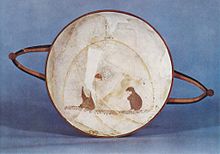51:
257:
who told them "A marvelous creature has been born amongst you: whoever finds the true likeness for this creature will also find the child." They interpreted this to refer to a newborn calf in Minos' herd. Three times a day, the calf changed color from white to red to black.
281:
away from a wine-cellar in Minos' palace. Inside the wine-cellar was a cask of honey, with
Glaucus dead inside. Minos demanded Glaucus be brought back to life, though Polyidus objected. Minos ordered Polyidus to be entombed with the body. When a
301:. Polyidus did so, but then, at the last second before leaving, he asked Glaucus to spit in his mouth. Glaucus did so and forgot everything he had been taught. The story of Polyidus and Glaucus was the subject of a lost play attributed to
447:
409:
with an
English Translation by Sir James George Frazer, F.B.A., F.R.S. in 2 Volumes, Cambridge, MA, Harvard University Press; London, William Heinemann Ltd. 1921.
286:
appeared nearby, Polyidus killed it immediately. Another snake came for the first, and after seeing its mate dead, the second serpent left and brought back a
477:
374:
467:
452:
426:
402:
370:
290:
which then brought the first snake back to life. Following this example, Polyidus used the same herb to resurrect
Glaucus.
309:, introducing to them the military girdle and shield. This was the source of his Italian name, Labicus, meaning "girdled".
472:
442:
211:
119:
103:
436:
413:
410:
203:
111:
389:
354:
223:
107:
219:
115:
20:
215:
332:, a mythological figure whose myth also included a snake resurrecting another snake with a herb
396:
translated and edited by Mary Grant. University of Kansas
Publications in Humanistic Studies.
85:
141:
132:
461:
313:
171:
195:
55:
Glaucus (right) depicted on a white-ground cup attributed to the
Sotades Painter
50:
266:, god of medicine) observed the similarity to the ripening of the fruit of the
298:
316:, who was a priestess of Phoebus Apollo and Diana Trivia who features in The
302:
263:
335:
267:
259:
123:
81:
329:
227:
207:
99:
95:
418:
317:
254:
250:
199:
306:
294:
283:
243:
183:
179:
77:
36:
397:
425:
Theodore C. Williams. trans. Boston. Houghton
Mifflin Co. 1910.
287:
239:
178:
means "greyish blue" or "bluish green" and "glimmering") was a
278:
274:
153:
159:
147:
448:
Dictionary of Greek and Roman
Biography and Mythology
162:
156:
150:
437:
Latin text available at the
Perseus Digital Library
144:
91:
73:
68:
60:
28:
249:Unable to find their son, his parents went to the
435:. J. B. Greenough. Boston. Ginn & Co. 1900.
427:Online version at the Perseus Digital Library.
411:Online version at the Perseus Digital Library.
242:or chasing a mouse Glaucus fell into a jar of
8:
270:plant, and Minos sent him to find Glaucus.
414:Greek text available from the same website
305:. Glaucus later led an army that attacked
49:
398:Online version at the Topos Text Project.
347:
273:Searching for the boy, Polyidus saw an
25:
7:
293:Minos refused to let Polyidus leave
297:until he taught Glaucus the art of
14:
394:Fabulae from The Myths of Hyginus
44:Member of the Cretan Royal Family
140:
478:LGBT themes in Greek mythology
433:Bucolics, Aeneid, and Georgics
312:Glaucus had a daughter called
238:One day, while playing with a
1:
16:Cretan prince, son of Minos
494:
468:Princes in Greek mythology
194:Glaucus' mother was Queen
182:prince as the son of King
18:
48:
43:
33:
431:Publius Vergilius Maro,
202:, and thus, brother to
419:Publius Vergilius Maro
473:Mythological Cretans
390:Gaius Julius Hyginus
19:For other uses, see
21:Glaucus (mythology)
403:Pseudo-Apollodorus
451:, London (1873).
129:
128:
485:
377:
368:
362:
352:
169:
168:
165:
164:
161:
158:
155:
152:
149:
146:
53:
26:
493:
492:
488:
487:
486:
484:
483:
482:
458:
457:
386:
381:
380:
369:
365:
353:
349:
344:
326:
236:
192:
143:
139:
133:Greek mythology
56:
39:
24:
17:
12:
11:
5:
491:
489:
481:
480:
475:
470:
460:
459:
456:
455:
443:Smith, William
440:
429:
416:
400:
385:
382:
379:
378:
363:
346:
345:
343:
340:
339:
338:
333:
325:
322:
235:
232:
198:, daughter of
191:
188:
127:
126:
93:
89:
88:
75:
71:
70:
66:
65:
62:
58:
57:
54:
46:
45:
41:
40:
34:
31:
30:
15:
13:
10:
9:
6:
4:
3:
2:
490:
479:
476:
474:
471:
469:
466:
465:
463:
454:
450:
449:
444:
441:
438:
434:
430:
428:
424:
420:
417:
415:
412:
408:
404:
401:
399:
395:
391:
388:
387:
383:
376:
372:
367:
364:
360:
356:
351:
348:
341:
337:
334:
331:
328:
327:
323:
321:
319:
315:
310:
308:
304:
300:
296:
291:
289:
285:
280:
276:
271:
269:
265:
261:
256:
252:
247:
245:
241:
233:
231:
229:
225:
221:
217:
213:
209:
205:
201:
197:
189:
187:
185:
181:
177:
173:
172:Ancient Greek
167:
138:
134:
125:
121:
117:
113:
109:
105:
101:
97:
94:
90:
87:
83:
79:
76:
72:
67:
63:
59:
52:
47:
42:
38:
32:
27:
22:
453:"Glaucus" 6.
446:
432:
422:
406:
393:
366:
358:
350:
311:
292:
272:
248:
237:
193:
175:
136:
130:
407:The Library
371:Apollodorus
320:in Book 6.
35:Prince of
462:Categories
384:References
299:divination
246:and died.
174:: Γλαῦκος
303:Euripides
264:Asclepius
234:Mythology
216:Deucalion
212:Androgeus
204:Acacallis
120:Deucalion
112:Acacallis
104:Androgeus
69:Genealogy
336:Tiresias
324:See also
314:Deiphobe
277:driving
268:mulberry
260:Polyidus
224:Xenodice
196:Pasiphaë
124:Minotaur
108:Xenodice
92:Siblings
82:Pasiphae
423:Aeneid.
359:Fabulae
355:Hyginus
330:Damasen
228:Catreus
220:Phaedra
208:Ariadne
176:Glaukos
137:Glaucus
116:Phaedra
100:Ariadne
96:Catreus
74:Parents
29:Glaucus
318:Aeneid
255:Delphi
251:Oracle
226:, and
200:Helios
190:Family
180:Cretan
122:; the
375:3.3.1
342:Notes
307:Italy
295:Crete
284:snake
244:honey
184:Minos
86:Crete
78:Minos
64:Crete
61:Abode
37:Crete
288:herb
279:bees
262:(or
240:ball
118:and
80:and
361:136
275:owl
253:at
131:In
84:or
464::
445:;
421:,
405:,
392:,
373:,
357:,
230:.
222:,
218:,
214:,
210:,
206:,
186:.
154:ɔː
135:,
114:,
110:,
106:,
102:,
98:,
439:.
170:(
166:/
163:s
160:ə
157:k
151:l
148:ɡ
145:ˈ
142:/
23:.
Text is available under the Creative Commons Attribution-ShareAlike License. Additional terms may apply.
